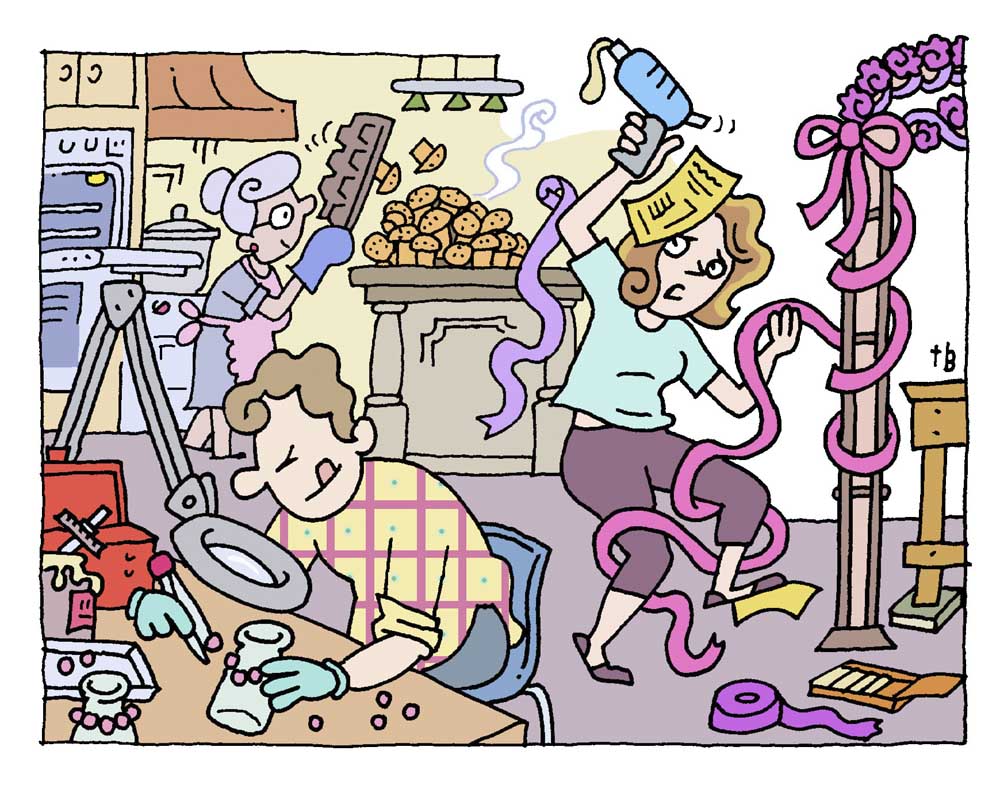Pompoms to ketubahs: the DIY wedding
Published 12:00 am Sunday, November 29, 2015

- Tom Bloom / The New York TimesA recent craze sees couples (and their friends and families) working hard for personalized weddings.
NEW YORK — For those couples who like to exhibit their inner Michelangelo or Martha Stewart, weddings have become festivals of do-it-yourself creativity. But in the days leading up to the event, a couple’s desire for those artisanal touches can come at a cost in lost hours and increased anxiety.
Why does a fork rent for 57 cents a night? Do folding chairs work for hoisting the bride and groom during the hora? (No.) How do you scrub pigeon droppings from a brick aisle?
Trending
I worried about all this and more as I prepared for my daughter’s wedding. But figuring out the answers was nothing compared with what my daughter, Rachel Wood, an international health analyst at the Department of Health and Human Services by day, was doing evenings and weekends at her Washington apartment.
In the months before the ceremony, she designed a wedding website, invitations, programs, menus, table banners and (less arduously) signature drinks. A few days before her wedding, she spent hours building a seating chart imposed on a world map, an idea she lifted from, where else, Pinterest, the do-it-yourself mother ship. Besides putting her personal stamp on her wedding, all of her crafting saved us an estimated $10,000.
While some make their own food and vows, most confine their DIY skills to labor-intensive peripherals. On Pinterest, the more popular of these items are glitter tea lights, wax-paper lanterns, tissue-paper pompoms, Jenga guest books and felt peonies. And how many hours might those projects require for completion? If you have to ask, you probably don’t have enough time.
BuzzFeed (not necessarily helpfully) offers 36 ways to save the date, including paper cutouts, 3-D-coded messages, movie posters, paper airplanes and temporary tattoos. Whatever you do, someone else is doing more. And doing it better.
“Pinterest sent me over the edge,” said Dara Matthews, who is studying to be a social worker. She married Jeremy Sklarsky, a computer coder, a year ago in the Hudson Valley. “It made me crazy. While it helped inspire some creative ideas, it also heightened my inferiority complex.”
Couples can acquire skills by taking wedding tutorials on woodworking, calligraphy, mixology and succulent terrariums. It helps if a bride and groom can wield a hot-glue gun and value their leisure time at close to zero.
Trending
Matthews and Sklarsky gave up bike rides and beach visits to tint Mason jars (fun), tie-dye table runners (not fun) and make old 45 rpm records into table numbers.
“DIY took more time and effort than we planned, and friends and family ended up helping out more than they anticipated,” Matthews said. “The ‘yourself’ in DIY means you and everyone you know who can help get it done. But everything turned out great.”
A 2014 survey of 15,000 couples conducted by the wedding-media company The Knot found that 87 percent had one or more do-it-yourself items, said Jamie Miles, managing editor of theknot.com.
As the cost of weddings rise, the number of couples turning to DIY is growing, said Darcy Miller, the editorial director of Martha Stewart Weddings. There is an added benefit, she said: A couple can “make their wedding their own.”
Lindsay Scola, the director of external affairs for Mayor Bill de Blasio’s office of media and entertainment and a former advance woman for President Barack Obama, knows how to organize. For the 2013 wedding of her sister, Mallory Selzo, a biomedical engineer at Siemens Medical, Scola divided friends and family into teams and handed out jobs.
Selzo designed her own ketubah (the traditional Jewish marriage contract), table flags, seat assignments and signage. Teams built a lace and PVC-pipe wedding canopy and cut pink tissue paper to make biodegradable confetti. The project saved them money and had the unanticipated benefit of bonding family and friends, Scola said, “even if my mother would now like Pinterest removed from the Internet.”
After being together for 10 years, Lia Bleichfeld and Piper Kristensen married in August at the groom’s family home in Woodstock, Vermont. The groom and his father and friends carted an old maple stump from the forest back to their home, where they hollowed it out with a chain saw, transforming the base into an outdoor beer and cider tap.
Guests were invited to arrive days before the wedding.
“We had friends there for a whole week, cooking and prepping,” Bleichfeld said. Those who had salad duty “did not imagine they would be rolling up their sleeves and putting their arms elbow deep into two feet of quinoa,” she said, recalling them mixing in tomatoes, olives, feta, cucumber, parsley and red onion for the salad. “I think our guests felt they earned the celebration in the end.”
My daughter and her husband, Andrew Rakestraw, a negotiator for international climate change at the State Department, had been together for almost eight years. Because their lives were long intertwined, she said, the wedding “became less a coming together and more a celebration of who we are.”
“Your rational mind goes out the window,” she said. “Everyone says love isn’t rational. Maybe planning a wedding isn’t, either.”








